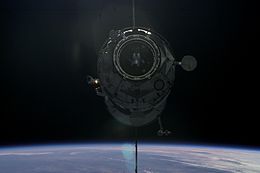cosmos.wikisort.org - Spacecraft
Progress DC-1 (Originally designated Progress SO1) was a modified Progress 11F615A55, Russian production No. 301, used to deliver the Pirs module to the International Space Station.[1] It has the pressurised cargo module removed to accommodate Pirs.[2]
 Progress DC-1 approaching the ISS with Pirs. | |
| Mission type | ISS assembly |
|---|---|
| Operator | Roscosmos |
| COSPAR ID | 2001-041A |
| SATCAT no. | 26908 |
| Mission duration | 13 days |
| Spacecraft properties | |
| Spacecraft type | Progress-M (modified) s/n 301 |
| Manufacturer | RKK Energia |
| Launch mass | 6900 kg |
| Start of mission | |
| Launch date | 14 September 2001, 23:34:55 UTC |
| Rocket | Soyuz-U |
| Launch site | Baikonur, Site 1/5 |
| End of mission | |
| Disposal | Deorbited |
| Decay date | 27 September 2001, 00:01 UTC |
| Orbital parameters | |
| Reference system | Geocentric |
| Regime | Low Earth |
| Perigee altitude | 388.2 km |
| Apogee altitude | 393.6 km |
| Inclination | 51.6° |
| Period | 92.3 minutes |
| Epoch | 14 September 2001 |
| Docking with ISS | |
| Docking port | Zvezda nadir (Pirs) |
| Docking date | 17 September 2001, 01:05 UTC |
| Undocking date | 26 September 2001, 15:36 UTC |
| Time docked | 9 days |
| Payload | |
| Pirs | |
| Mass | 3580 kg |
Progress ISS assembly | |
Launch
Progress DC-1 was launched by a Soyuz-U carrier rocket from Site 1/5 at the Baikonur Cosmodrome. Launch occurred at 23:34:55 UTC on 14 September 2001.[2]
Docking
The spacecraft docked with the nadir port of the Zvezda module at 01:05 UTC on 17 September 2001.[3] It remained docked for nine days
Undocking and Decay
On 26 September 2001 at 15:36 UTC it was jettisoned from Pirs. It was deorbited at 23:30 UTC on the same day, and burned up in the atmosphere over the Pacific Ocean, with any remaining debris landing in the ocean at around 00:01 UTC on 27 September 2001.[4]
See also
- List of Progress flights
- Uncrewed spaceflights to the International Space Station
- Progress M-MIM2
- Progress M-UM
References
- Zak, Anatoly. "Progress cargo ship". RussianSpaceWeb. Retrieved 7 June 2009.
- McDowell, Jonathan. "Launch Log". Jonathan's Space Page. Retrieved 7 June 2009.
- Wade, Mark. "Progress DC-1". Encyclopedia Astronautica. Archived from the original on 12 June 2002. Retrieved 7 June 2009.
- McDowell, Jonathan. "Satellite Catalog". Jonathan's Space Page. Retrieved 7 June 2009.
На других языках
- [en] Progress DC-1
[ru] Прогресс М-СО1
Прогресс М-СО1 — специализированный транспортный грузовой корабль-модуль (ГКМ) серии «Прогресс», запущен к Международной космической станции.[1] Серийный номер 301.[2]Другой контент может иметь иную лицензию. Перед использованием материалов сайта WikiSort.org внимательно изучите правила лицензирования конкретных элементов наполнения сайта.
WikiSort.org - проект по пересортировке и дополнению контента Википедии
